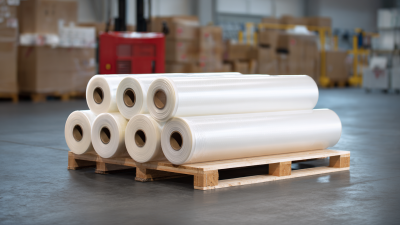As the global market for packaging solutions continues to evolve, the demand for effective and versatile options like Shrink Wrap has surged dramatically. According to a recent report by Smithers Pira, the global shrink film market is projected to reach $7.3 billion by 2025, reflecting a compound annual growth rate (CAGR) of 5.1%. This growth is fueled by the increasing need for sustainable and cost-effective packaging solutions across various industries, including food and beverage, pharmaceuticals, and consumer goods. Mastering Shrink Wrap techniques not only enhances product protection and extends shelf life but also plays a crucial role in branding and shelf appeal. This comprehensive tutorial will delve into the top strategies for effectively utilizing Shrink Wrap, empowering global buyers to navigate the complexities of packaging with confidence and competence.

Shrink wrap, also known as shrink film, is a versatile packaging material extensively used across various industries. It is created from polyethylene or polyvinyl chloride (PVC) and is designed to shrink tightly over products when heat is applied. This creates a secure, protective cover that offers moisture resistance and tamper evidence. According to a report by Transparency Market Research, the global shrink wrap market is predicted to reach USD 10.77 billion by 2026, reflecting an increasing adoption in sectors such as food and beverage, consumer goods, and pharmaceuticals.
The industrial applications of shrink wrap are vast. It is widely used for packaging products ranging from food items to electronics, where its ability to conform to the product shape helps minimize space and shipping costs. Additionally, shrink wrap is valuable for protecting goods from dust and moisture during transportation and storage. The growing trend towards sustainable packaging solutions has also led to innovations in shrink wrap materials, with many manufacturers developing biodegradable options. As companies become more environmentally conscious, the demand for eco-friendly shrink wrap alternatives continues to rise, further propelling the market's growth.
 Shrink wrap is an invaluable packaging solution for global buyers, boasting significant cost efficiency and exceptional product protection. By tightly sealing products, shrink wrap acts as a barrier against dust, moisture, and damage, ensuring that items reach their destination in pristine condition. This protective barrier minimizes the chances of returns and enhances customer satisfaction, making it a preferred choice for businesses of all sizes.
Shrink wrap is an invaluable packaging solution for global buyers, boasting significant cost efficiency and exceptional product protection. By tightly sealing products, shrink wrap acts as a barrier against dust, moisture, and damage, ensuring that items reach their destination in pristine condition. This protective barrier minimizes the chances of returns and enhances customer satisfaction, making it a preferred choice for businesses of all sizes.
To maximize the benefits of shrink wrap, it's important to consider the materials used. Opt for high-quality shrink films that offer durability and flexibility, which can accommodate various product shapes and sizes. Additionally, always ensure that the sealing process is performed meticulously; any gaps can compromise the integrity of the packaging.
Another tip is to invest in appropriate machinery that suits your production scale. For smaller batches, handheld heat guns may suffice, while larger operations benefit from automatic shrink wrap machines that streamline the process, saving time and labor costs. Proper training on machine operation and maintenance can also enhance efficiency and prolong equipment lifespan, contributing to overall cost savings.
In recent years, the market for shrink wrap materials has witnessed significant growth, driven by various sectors including packaging, food preservation, and retail. The analysis of market trends indicates a rising adoption of nano stretch film, known for its exceptional strength and thin profile. With 55 layers of different polymers, this advanced packaging solution is specifically designed to enhance pallet stability, meeting the demands of modern logistics.
When considering the types of shrink wrap available, buyers should evaluate their needs based on material and application. Popular options include acrylic nails, gel nails, and dip powders in the artificial nail segment, while diverse shrink wrap options serve various protective purposes in the retail and food industry.
**Tips:** When selecting shrink wrap, consider the environment it will be used in—factors like temperature and moisture can affect performance. Additionally, always assess compatibility with your products to prevent damage during transit. Lastly, explore online retailers for a broader range of options and competitive pricing.
When it comes to selecting the right shrink wrap equipment, global buyers must navigate a myriad of options, each tailored to specific needs and applications. Understanding your packaging requirements is crucial. Consider factors such as the size and shape of the products you intend to wrap, the required sealing speed, and the environmental conditions they will encounter during storage and transport. Researching various equipment types, such as manual, semi-automatic, and fully automatic machines, can help you align your budget with functionality, ensuring that you choose the right machine that meets both your volume needs and operational efficiency.
Additionally, it's vital to assess the quality and reliability of the shrink wrap machinery and manufacturers. Seek out equipment that offers durability, ease of maintenance, and compatibility with various film types. Reading reviews from other buyers and requesting demonstrations can provide insight into the performance of the equipment. Moreover, consider supplier support, including service contracts, part availability, and training for your staff, as these factors can impact the long-term success of your shrink wrap operations. By taking these steps, global buyers can confidently invest in the right shrink wrap equipment to enhance their packaging processes.
In recent years, sustainability has become a pivotal consideration in the packaging industry, particularly in shrink wrap materials. As global buyers seek eco-friendly options, manufacturers have begun innovating with biodegradable and compostable shrink films. These alternatives not only minimize environmental impact but also maintain the durability and protective qualities that shrink wrap is known for. Using materials derived from renewable resources, such as corn starch or recycled plastics, allows companies to reduce their carbon footprint while still providing reliable packaging solutions.
Furthermore, the shift towards sustainable shrink wrap is not just about material choice; it encompasses the entire production process. Innovations such as reduced thickness and energy-efficient manufacturing methods contribute to lowering overall waste and energy consumption. Many businesses are adopting practices like implementing closed-loop recycling systems to reclaim and reprocess used packaging. As these eco-friendly options gain traction, it's essential for global buyers to stay informed about the latest advancements and how they can integrate these solutions into their supply chains, ensuring that sustainability goes hand in hand with efficiency and cost-effectiveness.







